Managerial Accounting Report: TDABC for Uggs-N-Rugs, University Name
VerifiedAdded on 2020/05/16
|11
|2806
|135
Report
AI Summary
This report delves into the concept of Time Driven Activity Based Costing (TDABC) within the realm of managerial accounting. It begins with an introduction to cost accounting and its significance, particularly for manufacturing businesses, highlighting the emergence of TDABC as a modern costing method. The report then provides a detailed description of TDABC, its features, and contrasts it with Activity Based Costing (ABC) and traditional costing methods. A case study of Uggs-N-Rugs, a company manufacturing ugg boots, is used to illustrate the practical application and suitability of TDABC. The report emphasizes the benefits of TDABC, such as improved cost allocation, efficient resource utilization, and better decision-making capabilities for production managers. It also explores the differences between TDABC and traditional costing, emphasizing TDABC's ability to capture complex cost activities and provide a more accurate view of production costs. The report concludes by summarizing the suitability and utility of TDABC, advocating for its adoption by organizations like Uggs-N-Rugs to enhance their cost management and improve profitability. The report is a valuable resource for students seeking a thorough understanding of TDABC and its application in the real world.
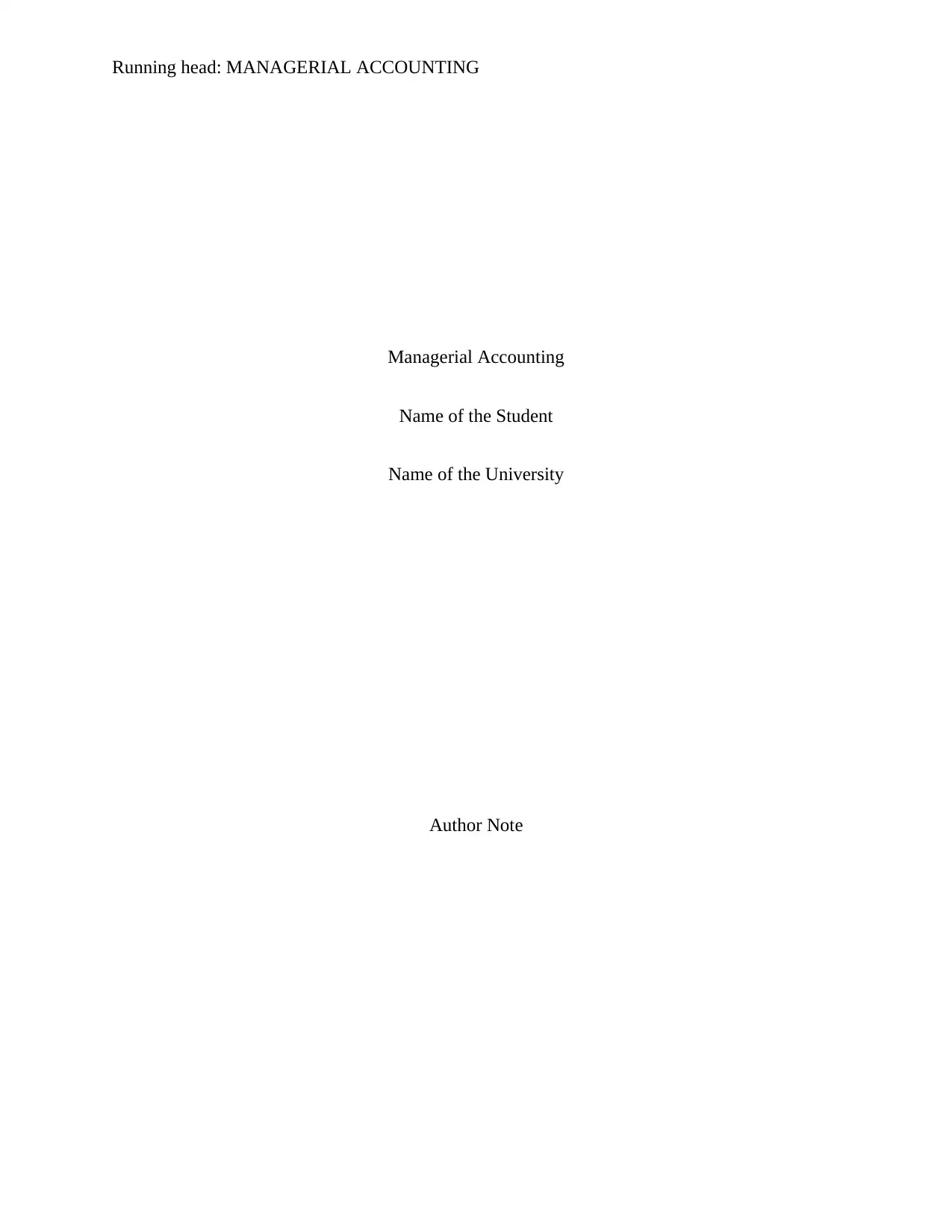
Running head: MANAGERIAL ACCOUNTING
Managerial Accounting
Name of the Student
Name of the University
Author Note
Managerial Accounting
Name of the Student
Name of the University
Author Note
Paraphrase This Document
Need a fresh take? Get an instant paraphrase of this document with our AI Paraphraser
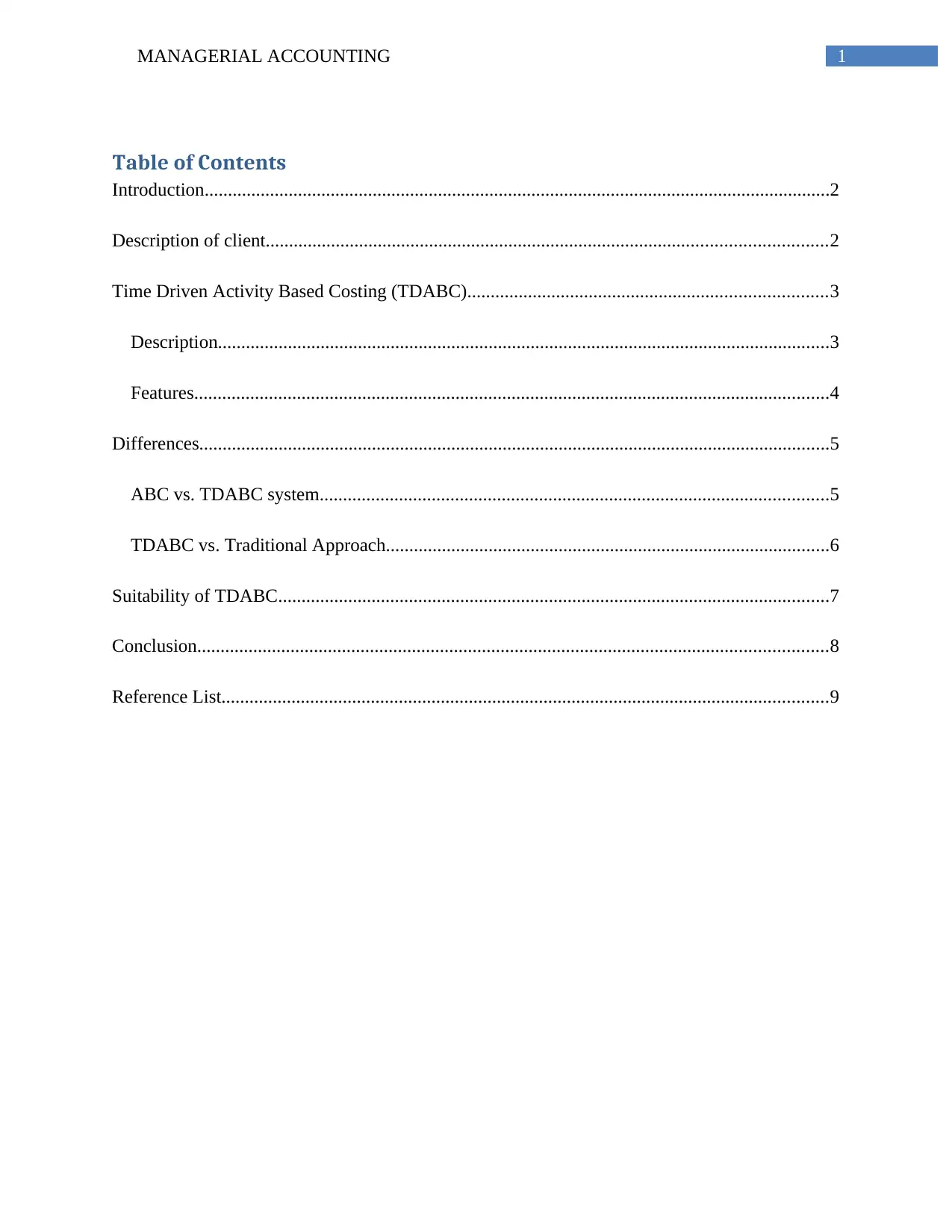
1MANAGERIAL ACCOUNTING
Table of Contents
Introduction......................................................................................................................................2
Description of client........................................................................................................................2
Time Driven Activity Based Costing (TDABC).............................................................................3
Description...................................................................................................................................3
Features........................................................................................................................................4
Differences.......................................................................................................................................5
ABC vs. TDABC system.............................................................................................................5
TDABC vs. Traditional Approach...............................................................................................6
Suitability of TDABC......................................................................................................................7
Conclusion.......................................................................................................................................8
Reference List..................................................................................................................................9
Table of Contents
Introduction......................................................................................................................................2
Description of client........................................................................................................................2
Time Driven Activity Based Costing (TDABC).............................................................................3
Description...................................................................................................................................3
Features........................................................................................................................................4
Differences.......................................................................................................................................5
ABC vs. TDABC system.............................................................................................................5
TDABC vs. Traditional Approach...............................................................................................6
Suitability of TDABC......................................................................................................................7
Conclusion.......................................................................................................................................8
Reference List..................................................................................................................................9
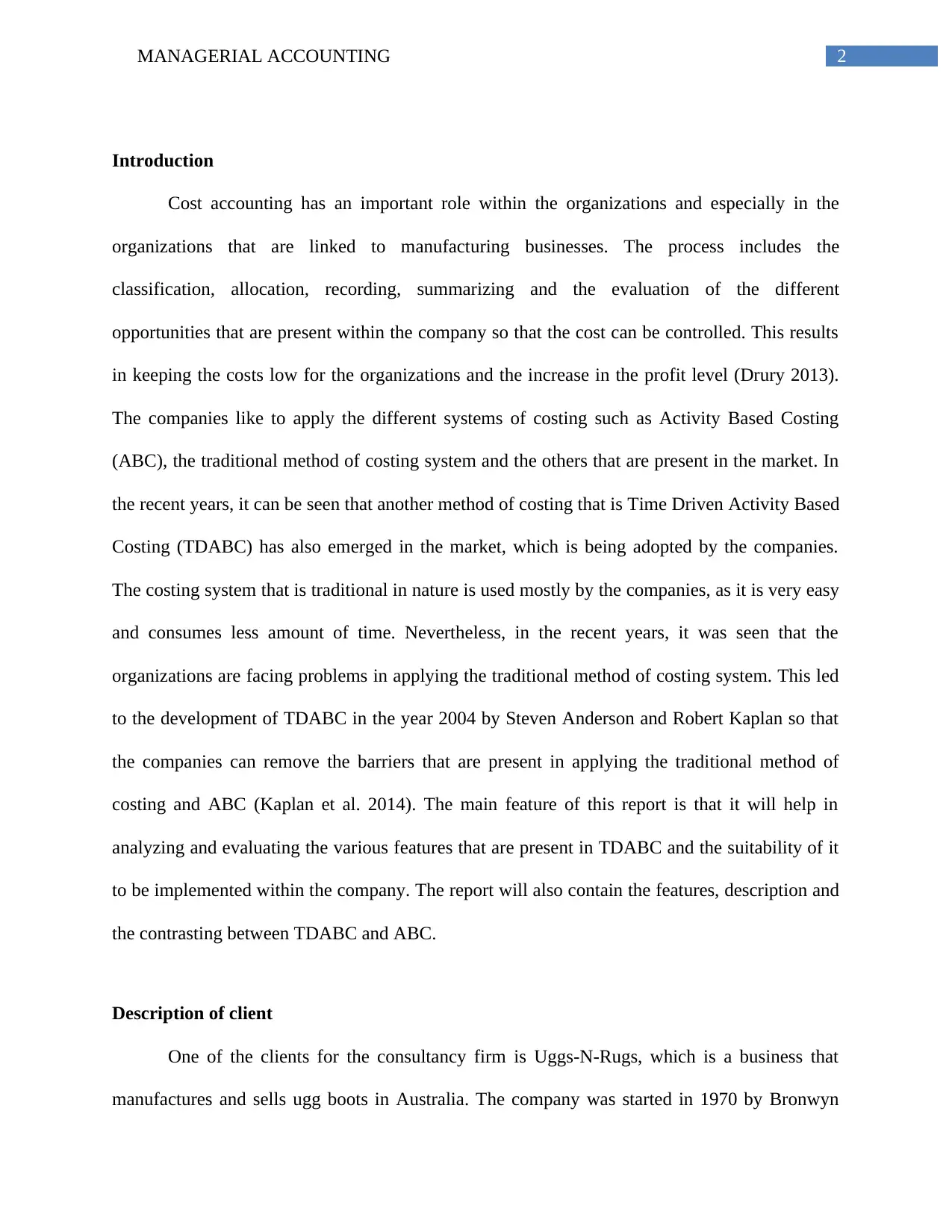
2MANAGERIAL ACCOUNTING
Introduction
Cost accounting has an important role within the organizations and especially in the
organizations that are linked to manufacturing businesses. The process includes the
classification, allocation, recording, summarizing and the evaluation of the different
opportunities that are present within the company so that the cost can be controlled. This results
in keeping the costs low for the organizations and the increase in the profit level (Drury 2013).
The companies like to apply the different systems of costing such as Activity Based Costing
(ABC), the traditional method of costing system and the others that are present in the market. In
the recent years, it can be seen that another method of costing that is Time Driven Activity Based
Costing (TDABC) has also emerged in the market, which is being adopted by the companies.
The costing system that is traditional in nature is used mostly by the companies, as it is very easy
and consumes less amount of time. Nevertheless, in the recent years, it was seen that the
organizations are facing problems in applying the traditional method of costing system. This led
to the development of TDABC in the year 2004 by Steven Anderson and Robert Kaplan so that
the companies can remove the barriers that are present in applying the traditional method of
costing and ABC (Kaplan et al. 2014). The main feature of this report is that it will help in
analyzing and evaluating the various features that are present in TDABC and the suitability of it
to be implemented within the company. The report will also contain the features, description and
the contrasting between TDABC and ABC.
Description of client
One of the clients for the consultancy firm is Uggs-N-Rugs, which is a business that
manufactures and sells ugg boots in Australia. The company was started in 1970 by Bronwyn
Introduction
Cost accounting has an important role within the organizations and especially in the
organizations that are linked to manufacturing businesses. The process includes the
classification, allocation, recording, summarizing and the evaluation of the different
opportunities that are present within the company so that the cost can be controlled. This results
in keeping the costs low for the organizations and the increase in the profit level (Drury 2013).
The companies like to apply the different systems of costing such as Activity Based Costing
(ABC), the traditional method of costing system and the others that are present in the market. In
the recent years, it can be seen that another method of costing that is Time Driven Activity Based
Costing (TDABC) has also emerged in the market, which is being adopted by the companies.
The costing system that is traditional in nature is used mostly by the companies, as it is very easy
and consumes less amount of time. Nevertheless, in the recent years, it was seen that the
organizations are facing problems in applying the traditional method of costing system. This led
to the development of TDABC in the year 2004 by Steven Anderson and Robert Kaplan so that
the companies can remove the barriers that are present in applying the traditional method of
costing and ABC (Kaplan et al. 2014). The main feature of this report is that it will help in
analyzing and evaluating the various features that are present in TDABC and the suitability of it
to be implemented within the company. The report will also contain the features, description and
the contrasting between TDABC and ABC.
Description of client
One of the clients for the consultancy firm is Uggs-N-Rugs, which is a business that
manufactures and sells ugg boots in Australia. The company was started in 1970 by Bronwyn
⊘ This is a preview!⊘
Do you want full access?
Subscribe today to unlock all pages.

Trusted by 1+ million students worldwide
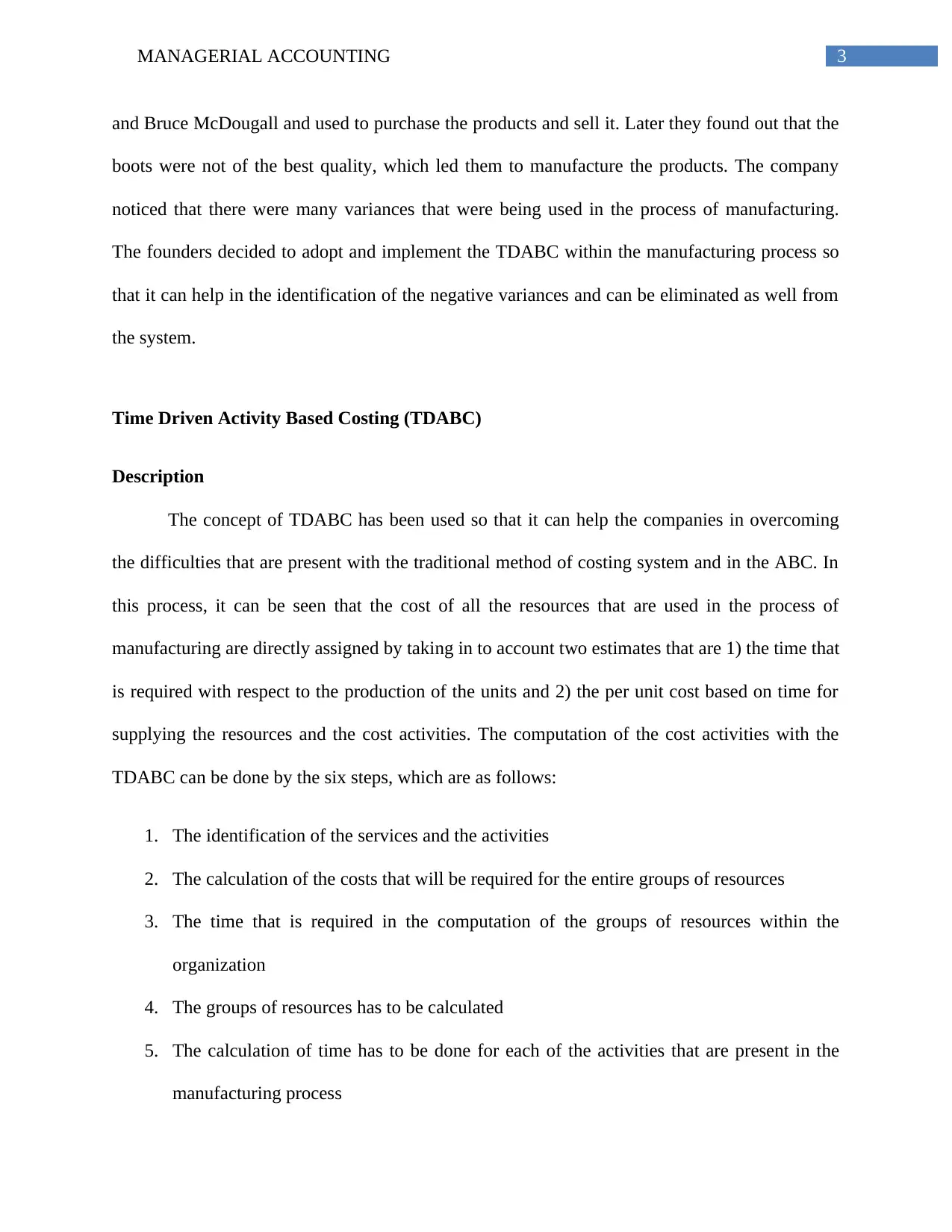
3MANAGERIAL ACCOUNTING
and Bruce McDougall and used to purchase the products and sell it. Later they found out that the
boots were not of the best quality, which led them to manufacture the products. The company
noticed that there were many variances that were being used in the process of manufacturing.
The founders decided to adopt and implement the TDABC within the manufacturing process so
that it can help in the identification of the negative variances and can be eliminated as well from
the system.
Time Driven Activity Based Costing (TDABC)
Description
The concept of TDABC has been used so that it can help the companies in overcoming
the difficulties that are present with the traditional method of costing system and in the ABC. In
this process, it can be seen that the cost of all the resources that are used in the process of
manufacturing are directly assigned by taking in to account two estimates that are 1) the time that
is required with respect to the production of the units and 2) the per unit cost based on time for
supplying the resources and the cost activities. The computation of the cost activities with the
TDABC can be done by the six steps, which are as follows:
1. The identification of the services and the activities
2. The calculation of the costs that will be required for the entire groups of resources
3. The time that is required in the computation of the groups of resources within the
organization
4. The groups of resources has to be calculated
5. The calculation of time has to be done for each of the activities that are present in the
manufacturing process
and Bruce McDougall and used to purchase the products and sell it. Later they found out that the
boots were not of the best quality, which led them to manufacture the products. The company
noticed that there were many variances that were being used in the process of manufacturing.
The founders decided to adopt and implement the TDABC within the manufacturing process so
that it can help in the identification of the negative variances and can be eliminated as well from
the system.
Time Driven Activity Based Costing (TDABC)
Description
The concept of TDABC has been used so that it can help the companies in overcoming
the difficulties that are present with the traditional method of costing system and in the ABC. In
this process, it can be seen that the cost of all the resources that are used in the process of
manufacturing are directly assigned by taking in to account two estimates that are 1) the time that
is required with respect to the production of the units and 2) the per unit cost based on time for
supplying the resources and the cost activities. The computation of the cost activities with the
TDABC can be done by the six steps, which are as follows:
1. The identification of the services and the activities
2. The calculation of the costs that will be required for the entire groups of resources
3. The time that is required in the computation of the groups of resources within the
organization
4. The groups of resources has to be calculated
5. The calculation of time has to be done for each of the activities that are present in the
manufacturing process
Paraphrase This Document
Need a fresh take? Get an instant paraphrase of this document with our AI Paraphraser
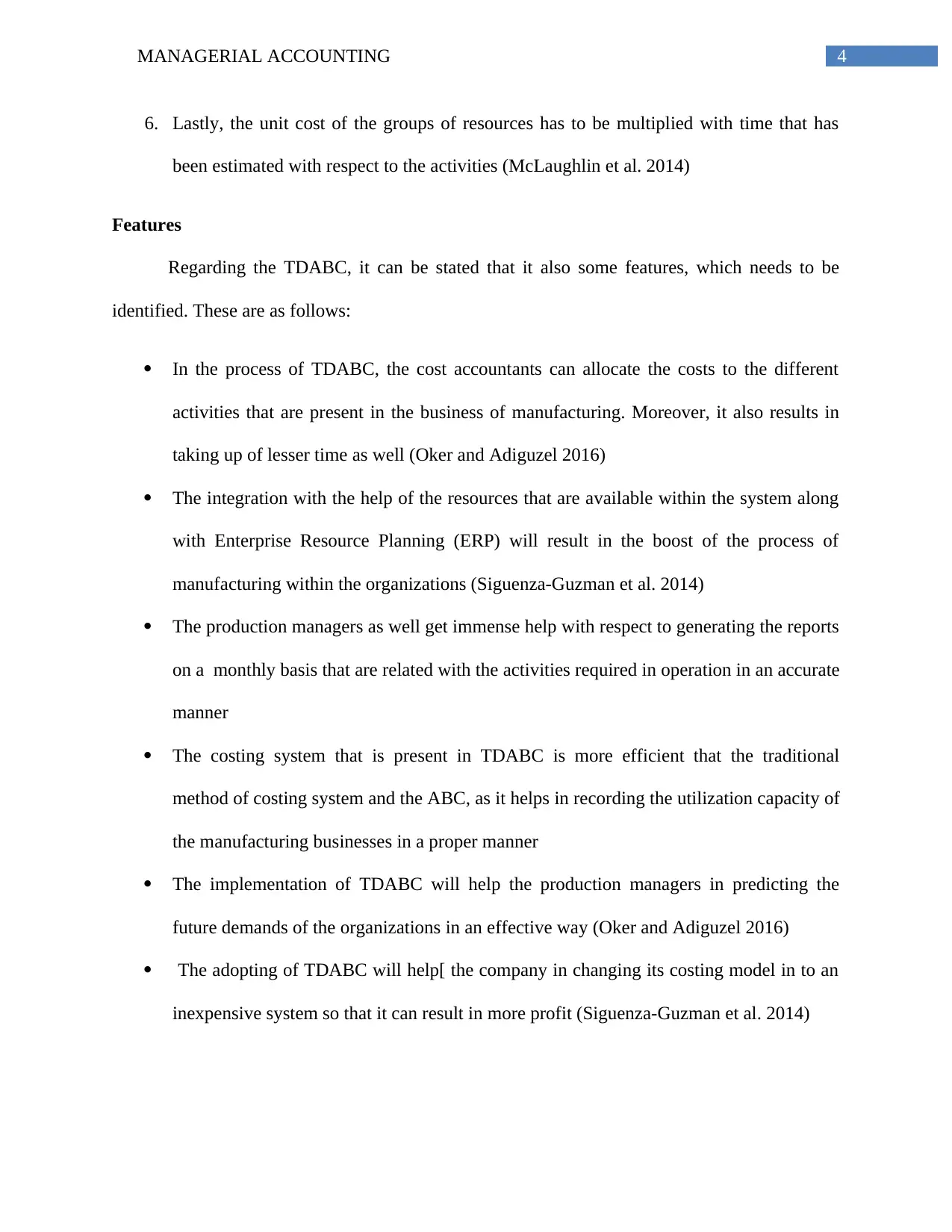
4MANAGERIAL ACCOUNTING
6. Lastly, the unit cost of the groups of resources has to be multiplied with time that has
been estimated with respect to the activities (McLaughlin et al. 2014)
Features
Regarding the TDABC, it can be stated that it also some features, which needs to be
identified. These are as follows:
In the process of TDABC, the cost accountants can allocate the costs to the different
activities that are present in the business of manufacturing. Moreover, it also results in
taking up of lesser time as well (Oker and Adiguzel 2016)
The integration with the help of the resources that are available within the system along
with Enterprise Resource Planning (ERP) will result in the boost of the process of
manufacturing within the organizations (Siguenza-Guzman et al. 2014)
The production managers as well get immense help with respect to generating the reports
on a monthly basis that are related with the activities required in operation in an accurate
manner
The costing system that is present in TDABC is more efficient that the traditional
method of costing system and the ABC, as it helps in recording the utilization capacity of
the manufacturing businesses in a proper manner
The implementation of TDABC will help the production managers in predicting the
future demands of the organizations in an effective way (Oker and Adiguzel 2016)
The adopting of TDABC will help[ the company in changing its costing model in to an
inexpensive system so that it can result in more profit (Siguenza-Guzman et al. 2014)
6. Lastly, the unit cost of the groups of resources has to be multiplied with time that has
been estimated with respect to the activities (McLaughlin et al. 2014)
Features
Regarding the TDABC, it can be stated that it also some features, which needs to be
identified. These are as follows:
In the process of TDABC, the cost accountants can allocate the costs to the different
activities that are present in the business of manufacturing. Moreover, it also results in
taking up of lesser time as well (Oker and Adiguzel 2016)
The integration with the help of the resources that are available within the system along
with Enterprise Resource Planning (ERP) will result in the boost of the process of
manufacturing within the organizations (Siguenza-Guzman et al. 2014)
The production managers as well get immense help with respect to generating the reports
on a monthly basis that are related with the activities required in operation in an accurate
manner
The costing system that is present in TDABC is more efficient that the traditional
method of costing system and the ABC, as it helps in recording the utilization capacity of
the manufacturing businesses in a proper manner
The implementation of TDABC will help the production managers in predicting the
future demands of the organizations in an effective way (Oker and Adiguzel 2016)
The adopting of TDABC will help[ the company in changing its costing model in to an
inexpensive system so that it can result in more profit (Siguenza-Guzman et al. 2014)
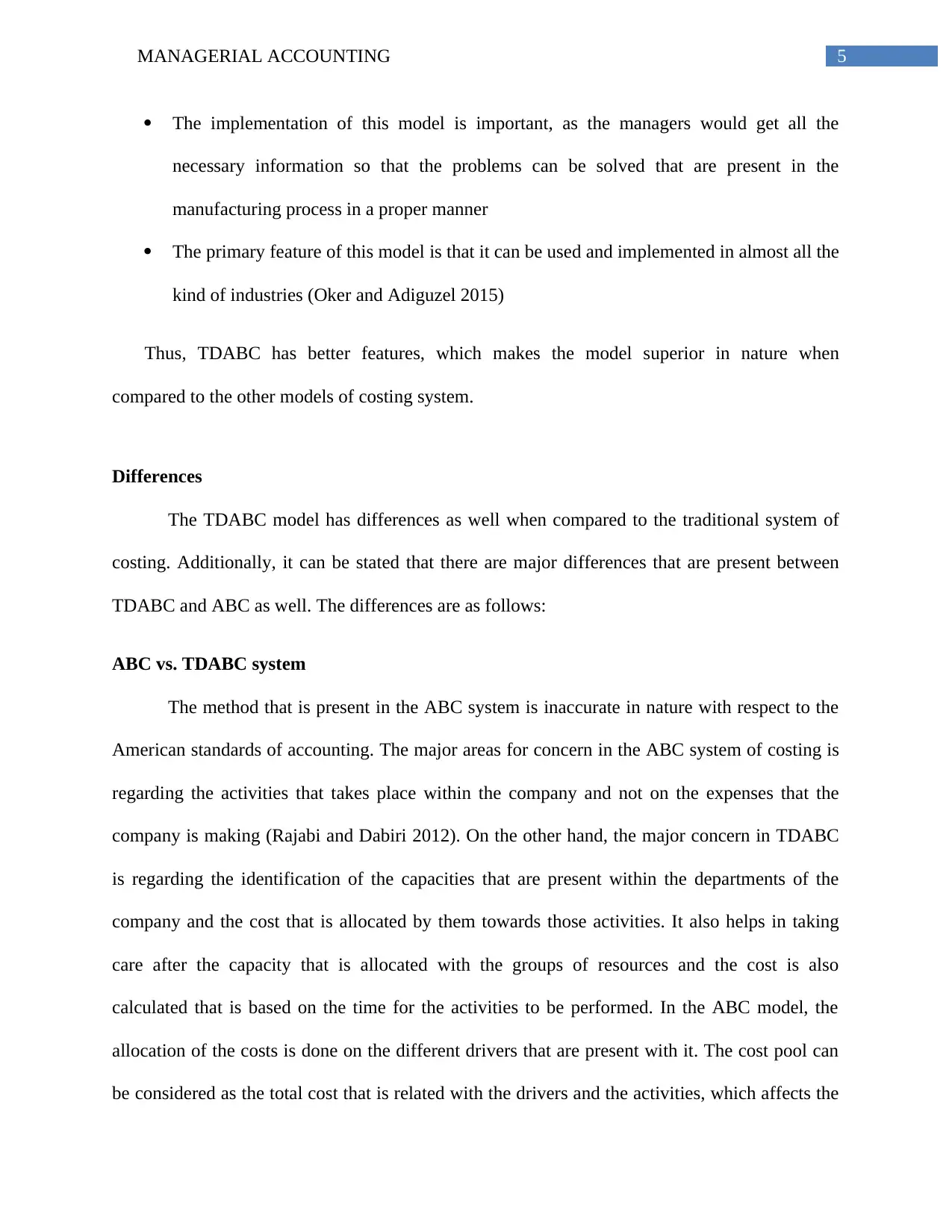
5MANAGERIAL ACCOUNTING
The implementation of this model is important, as the managers would get all the
necessary information so that the problems can be solved that are present in the
manufacturing process in a proper manner
The primary feature of this model is that it can be used and implemented in almost all the
kind of industries (Oker and Adiguzel 2015)
Thus, TDABC has better features, which makes the model superior in nature when
compared to the other models of costing system.
Differences
The TDABC model has differences as well when compared to the traditional system of
costing. Additionally, it can be stated that there are major differences that are present between
TDABC and ABC as well. The differences are as follows:
ABC vs. TDABC system
The method that is present in the ABC system is inaccurate in nature with respect to the
American standards of accounting. The major areas for concern in the ABC system of costing is
regarding the activities that takes place within the company and not on the expenses that the
company is making (Rajabi and Dabiri 2012). On the other hand, the major concern in TDABC
is regarding the identification of the capacities that are present within the departments of the
company and the cost that is allocated by them towards those activities. It also helps in taking
care after the capacity that is allocated with the groups of resources and the cost is also
calculated that is based on the time for the activities to be performed. In the ABC model, the
allocation of the costs is done on the different drivers that are present with it. The cost pool can
be considered as the total cost that is related with the drivers and the activities, which affects the
The implementation of this model is important, as the managers would get all the
necessary information so that the problems can be solved that are present in the
manufacturing process in a proper manner
The primary feature of this model is that it can be used and implemented in almost all the
kind of industries (Oker and Adiguzel 2015)
Thus, TDABC has better features, which makes the model superior in nature when
compared to the other models of costing system.
Differences
The TDABC model has differences as well when compared to the traditional system of
costing. Additionally, it can be stated that there are major differences that are present between
TDABC and ABC as well. The differences are as follows:
ABC vs. TDABC system
The method that is present in the ABC system is inaccurate in nature with respect to the
American standards of accounting. The major areas for concern in the ABC system of costing is
regarding the activities that takes place within the company and not on the expenses that the
company is making (Rajabi and Dabiri 2012). On the other hand, the major concern in TDABC
is regarding the identification of the capacities that are present within the departments of the
company and the cost that is allocated by them towards those activities. It also helps in taking
care after the capacity that is allocated with the groups of resources and the cost is also
calculated that is based on the time for the activities to be performed. In the ABC model, the
allocation of the costs is done on the different drivers that are present with it. The cost pool can
be considered as the total cost that is related with the drivers and the activities, which affects the
⊘ This is a preview!⊘
Do you want full access?
Subscribe today to unlock all pages.

Trusted by 1+ million students worldwide
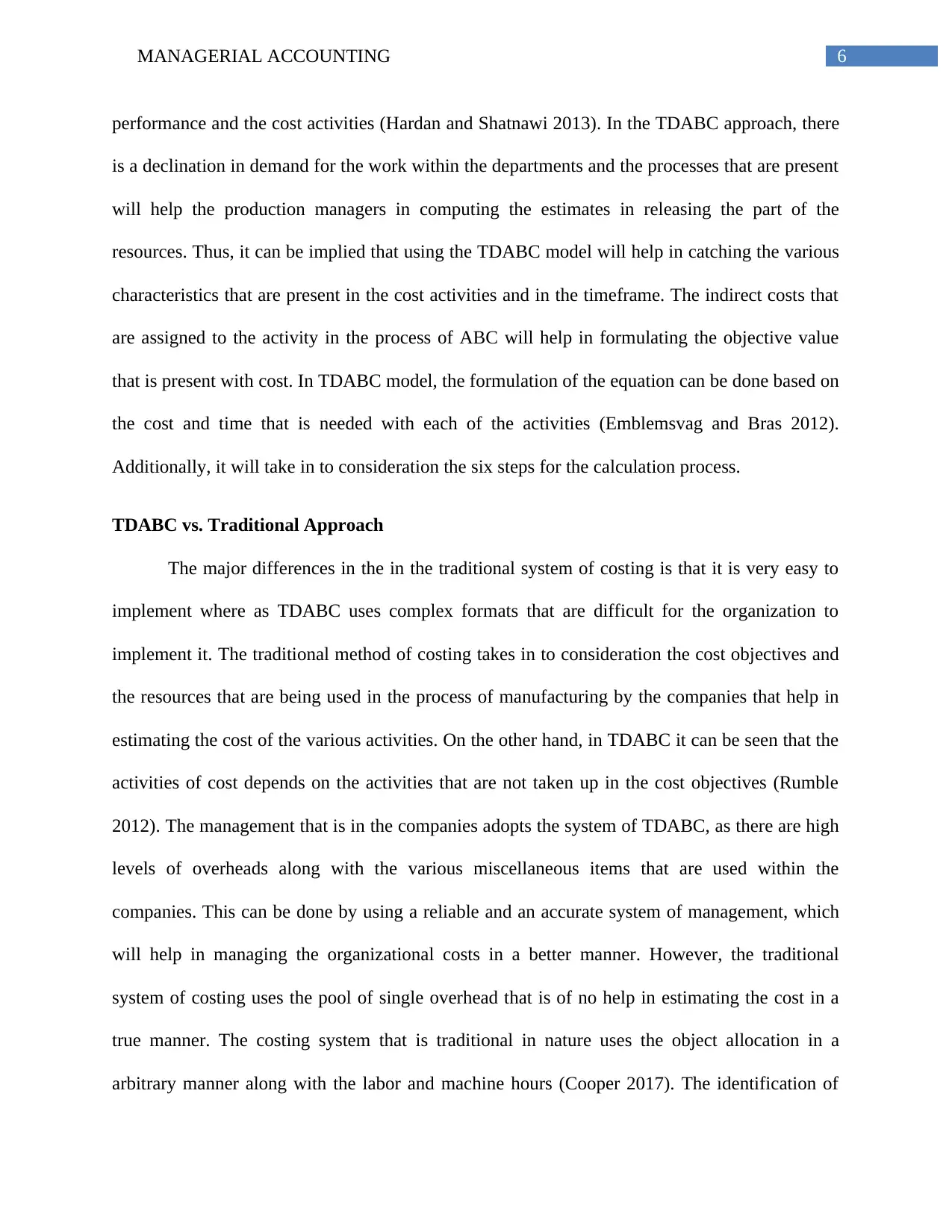
6MANAGERIAL ACCOUNTING
performance and the cost activities (Hardan and Shatnawi 2013). In the TDABC approach, there
is a declination in demand for the work within the departments and the processes that are present
will help the production managers in computing the estimates in releasing the part of the
resources. Thus, it can be implied that using the TDABC model will help in catching the various
characteristics that are present in the cost activities and in the timeframe. The indirect costs that
are assigned to the activity in the process of ABC will help in formulating the objective value
that is present with cost. In TDABC model, the formulation of the equation can be done based on
the cost and time that is needed with each of the activities (Emblemsvag and Bras 2012).
Additionally, it will take in to consideration the six steps for the calculation process.
TDABC vs. Traditional Approach
The major differences in the in the traditional system of costing is that it is very easy to
implement where as TDABC uses complex formats that are difficult for the organization to
implement it. The traditional method of costing takes in to consideration the cost objectives and
the resources that are being used in the process of manufacturing by the companies that help in
estimating the cost of the various activities. On the other hand, in TDABC it can be seen that the
activities of cost depends on the activities that are not taken up in the cost objectives (Rumble
2012). The management that is in the companies adopts the system of TDABC, as there are high
levels of overheads along with the various miscellaneous items that are used within the
companies. This can be done by using a reliable and an accurate system of management, which
will help in managing the organizational costs in a better manner. However, the traditional
system of costing uses the pool of single overhead that is of no help in estimating the cost in a
true manner. The costing system that is traditional in nature uses the object allocation in a
arbitrary manner along with the labor and machine hours (Cooper 2017). The identification of
performance and the cost activities (Hardan and Shatnawi 2013). In the TDABC approach, there
is a declination in demand for the work within the departments and the processes that are present
will help the production managers in computing the estimates in releasing the part of the
resources. Thus, it can be implied that using the TDABC model will help in catching the various
characteristics that are present in the cost activities and in the timeframe. The indirect costs that
are assigned to the activity in the process of ABC will help in formulating the objective value
that is present with cost. In TDABC model, the formulation of the equation can be done based on
the cost and time that is needed with each of the activities (Emblemsvag and Bras 2012).
Additionally, it will take in to consideration the six steps for the calculation process.
TDABC vs. Traditional Approach
The major differences in the in the traditional system of costing is that it is very easy to
implement where as TDABC uses complex formats that are difficult for the organization to
implement it. The traditional method of costing takes in to consideration the cost objectives and
the resources that are being used in the process of manufacturing by the companies that help in
estimating the cost of the various activities. On the other hand, in TDABC it can be seen that the
activities of cost depends on the activities that are not taken up in the cost objectives (Rumble
2012). The management that is in the companies adopts the system of TDABC, as there are high
levels of overheads along with the various miscellaneous items that are used within the
companies. This can be done by using a reliable and an accurate system of management, which
will help in managing the organizational costs in a better manner. However, the traditional
system of costing uses the pool of single overhead that is of no help in estimating the cost in a
true manner. The costing system that is traditional in nature uses the object allocation in a
arbitrary manner along with the labor and machine hours (Cooper 2017). The identification of
Paraphrase This Document
Need a fresh take? Get an instant paraphrase of this document with our AI Paraphraser

7MANAGERIAL ACCOUNTING
the products that helps in estimating the expenses such as salaries and depreciation are included
in the method of TDABC and in traditional method as well. Moreover, in the method of
TDABC, the accountants also take in to consideration the cost of production that is based on the
feedbacks received from the customers. The implementation of this method will help in
decreasing the cost of production so that production can be increased (Cohen 2014).
Suitability of TDABC
The above discussion helps in identifying the major differences that are in TDABC along
with its features. It is necessary to gain a better understanding of TDABC so that it can be used
up in the manufacturing industry. The suitability of this method is as follows:
This method helps the organizations in gaining a better knowledge with respect to the
cost activities and helps the the company in taking the decisions by using the strategies
that will help the manufacturing industry (Schulze, Seuring and Ewering 2012)
The other benefit hat can be enjoyed by the organization after the implementation of
TDABC is that it will help in illustrating the capacity to be used up and supplied. The
process of calculating the time so that the different activities can be carried out in a better
way. It will also provide support to the managers so that the costs can be managed in an
efficient manner within the organization. This will result in providing better idea to the
company with respect to the workloads that need to be increased in the different
departments (Rumble 2012)
It also results in taking in to consideration the Enterprise Resource Planning along with
the cost calculation in an accurate manner so that it can help in proper transactions within
the organization. TDABC can be implemented so that the cost of distribution can be
the products that helps in estimating the expenses such as salaries and depreciation are included
in the method of TDABC and in traditional method as well. Moreover, in the method of
TDABC, the accountants also take in to consideration the cost of production that is based on the
feedbacks received from the customers. The implementation of this method will help in
decreasing the cost of production so that production can be increased (Cohen 2014).
Suitability of TDABC
The above discussion helps in identifying the major differences that are in TDABC along
with its features. It is necessary to gain a better understanding of TDABC so that it can be used
up in the manufacturing industry. The suitability of this method is as follows:
This method helps the organizations in gaining a better knowledge with respect to the
cost activities and helps the the company in taking the decisions by using the strategies
that will help the manufacturing industry (Schulze, Seuring and Ewering 2012)
The other benefit hat can be enjoyed by the organization after the implementation of
TDABC is that it will help in illustrating the capacity to be used up and supplied. The
process of calculating the time so that the different activities can be carried out in a better
way. It will also provide support to the managers so that the costs can be managed in an
efficient manner within the organization. This will result in providing better idea to the
company with respect to the workloads that need to be increased in the different
departments (Rumble 2012)
It also results in taking in to consideration the Enterprise Resource Planning along with
the cost calculation in an accurate manner so that it can help in proper transactions within
the organization. TDABC can be implemented so that the cost of distribution can be
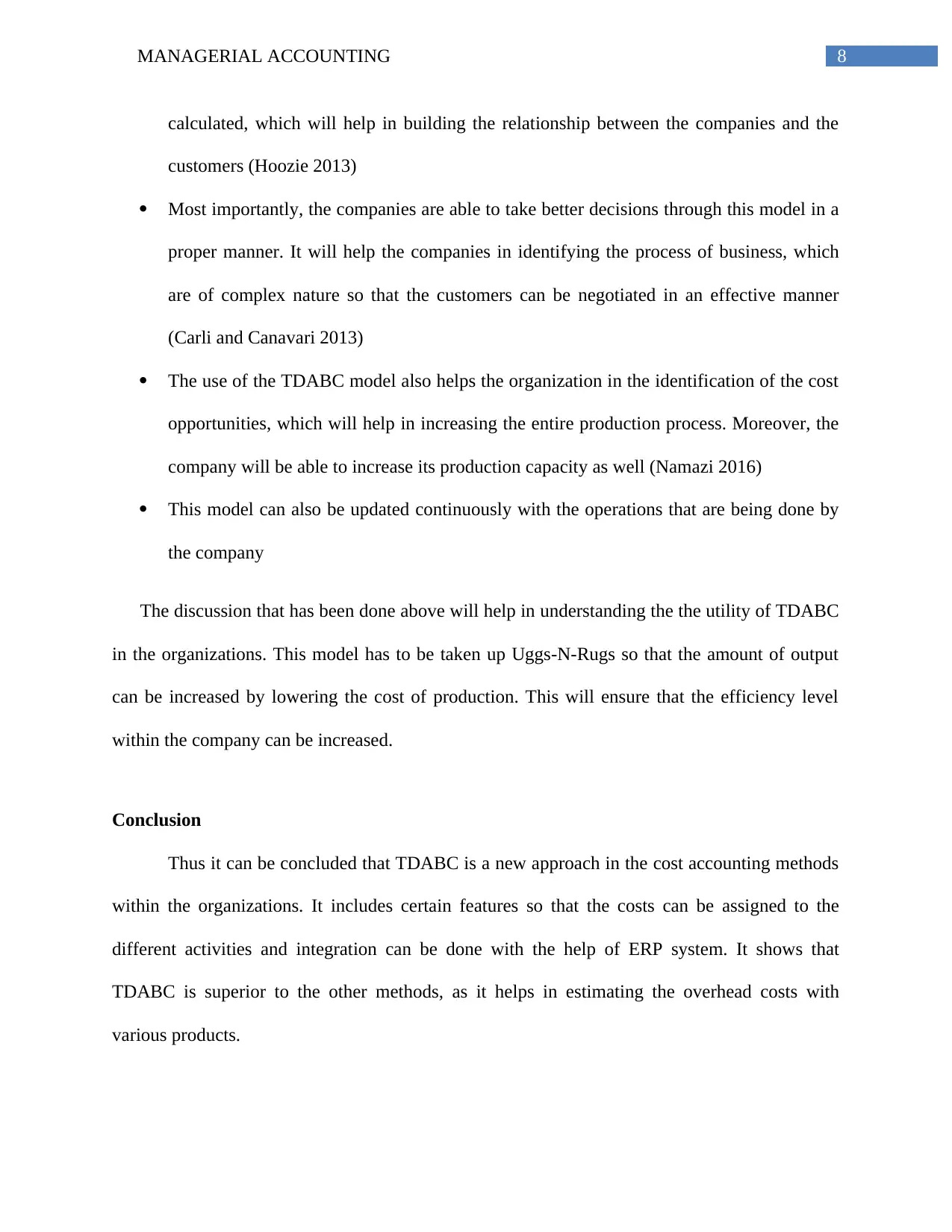
8MANAGERIAL ACCOUNTING
calculated, which will help in building the relationship between the companies and the
customers (Hoozie 2013)
Most importantly, the companies are able to take better decisions through this model in a
proper manner. It will help the companies in identifying the process of business, which
are of complex nature so that the customers can be negotiated in an effective manner
(Carli and Canavari 2013)
The use of the TDABC model also helps the organization in the identification of the cost
opportunities, which will help in increasing the entire production process. Moreover, the
company will be able to increase its production capacity as well (Namazi 2016)
This model can also be updated continuously with the operations that are being done by
the company
The discussion that has been done above will help in understanding the the utility of TDABC
in the organizations. This model has to be taken up Uggs-N-Rugs so that the amount of output
can be increased by lowering the cost of production. This will ensure that the efficiency level
within the company can be increased.
Conclusion
Thus it can be concluded that TDABC is a new approach in the cost accounting methods
within the organizations. It includes certain features so that the costs can be assigned to the
different activities and integration can be done with the help of ERP system. It shows that
TDABC is superior to the other methods, as it helps in estimating the overhead costs with
various products.
calculated, which will help in building the relationship between the companies and the
customers (Hoozie 2013)
Most importantly, the companies are able to take better decisions through this model in a
proper manner. It will help the companies in identifying the process of business, which
are of complex nature so that the customers can be negotiated in an effective manner
(Carli and Canavari 2013)
The use of the TDABC model also helps the organization in the identification of the cost
opportunities, which will help in increasing the entire production process. Moreover, the
company will be able to increase its production capacity as well (Namazi 2016)
This model can also be updated continuously with the operations that are being done by
the company
The discussion that has been done above will help in understanding the the utility of TDABC
in the organizations. This model has to be taken up Uggs-N-Rugs so that the amount of output
can be increased by lowering the cost of production. This will ensure that the efficiency level
within the company can be increased.
Conclusion
Thus it can be concluded that TDABC is a new approach in the cost accounting methods
within the organizations. It includes certain features so that the costs can be assigned to the
different activities and integration can be done with the help of ERP system. It shows that
TDABC is superior to the other methods, as it helps in estimating the overhead costs with
various products.
⊘ This is a preview!⊘
Do you want full access?
Subscribe today to unlock all pages.

Trusted by 1+ million students worldwide
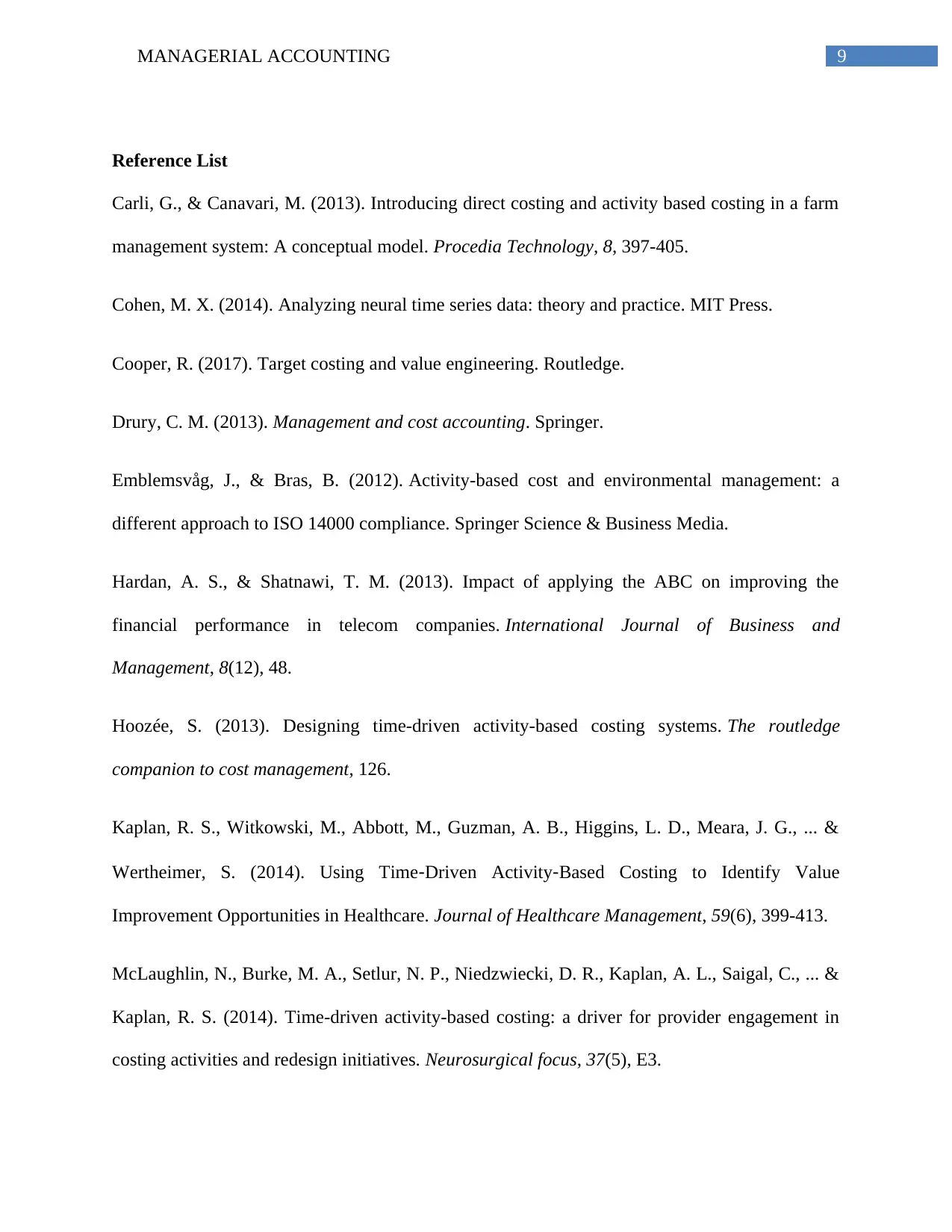
9MANAGERIAL ACCOUNTING
Reference List
Carli, G., & Canavari, M. (2013). Introducing direct costing and activity based costing in a farm
management system: A conceptual model. Procedia Technology, 8, 397-405.
Cohen, M. X. (2014). Analyzing neural time series data: theory and practice. MIT Press.
Cooper, R. (2017). Target costing and value engineering. Routledge.
Drury, C. M. (2013). Management and cost accounting. Springer.
Emblemsvåg, J., & Bras, B. (2012). Activity-based cost and environmental management: a
different approach to ISO 14000 compliance. Springer Science & Business Media.
Hardan, A. S., & Shatnawi, T. M. (2013). Impact of applying the ABC on improving the
financial performance in telecom companies. International Journal of Business and
Management, 8(12), 48.
Hoozée, S. (2013). Designing time-driven activity-based costing systems. The routledge
companion to cost management, 126.
Kaplan, R. S., Witkowski, M., Abbott, M., Guzman, A. B., Higgins, L. D., Meara, J. G., ... &
Wertheimer, S. (2014). Using Time‐Driven Activity‐Based Costing to Identify Value
Improvement Opportunities in Healthcare. Journal of Healthcare Management, 59(6), 399-413.
McLaughlin, N., Burke, M. A., Setlur, N. P., Niedzwiecki, D. R., Kaplan, A. L., Saigal, C., ... &
Kaplan, R. S. (2014). Time-driven activity-based costing: a driver for provider engagement in
costing activities and redesign initiatives. Neurosurgical focus, 37(5), E3.
Reference List
Carli, G., & Canavari, M. (2013). Introducing direct costing and activity based costing in a farm
management system: A conceptual model. Procedia Technology, 8, 397-405.
Cohen, M. X. (2014). Analyzing neural time series data: theory and practice. MIT Press.
Cooper, R. (2017). Target costing and value engineering. Routledge.
Drury, C. M. (2013). Management and cost accounting. Springer.
Emblemsvåg, J., & Bras, B. (2012). Activity-based cost and environmental management: a
different approach to ISO 14000 compliance. Springer Science & Business Media.
Hardan, A. S., & Shatnawi, T. M. (2013). Impact of applying the ABC on improving the
financial performance in telecom companies. International Journal of Business and
Management, 8(12), 48.
Hoozée, S. (2013). Designing time-driven activity-based costing systems. The routledge
companion to cost management, 126.
Kaplan, R. S., Witkowski, M., Abbott, M., Guzman, A. B., Higgins, L. D., Meara, J. G., ... &
Wertheimer, S. (2014). Using Time‐Driven Activity‐Based Costing to Identify Value
Improvement Opportunities in Healthcare. Journal of Healthcare Management, 59(6), 399-413.
McLaughlin, N., Burke, M. A., Setlur, N. P., Niedzwiecki, D. R., Kaplan, A. L., Saigal, C., ... &
Kaplan, R. S. (2014). Time-driven activity-based costing: a driver for provider engagement in
costing activities and redesign initiatives. Neurosurgical focus, 37(5), E3.
Paraphrase This Document
Need a fresh take? Get an instant paraphrase of this document with our AI Paraphraser
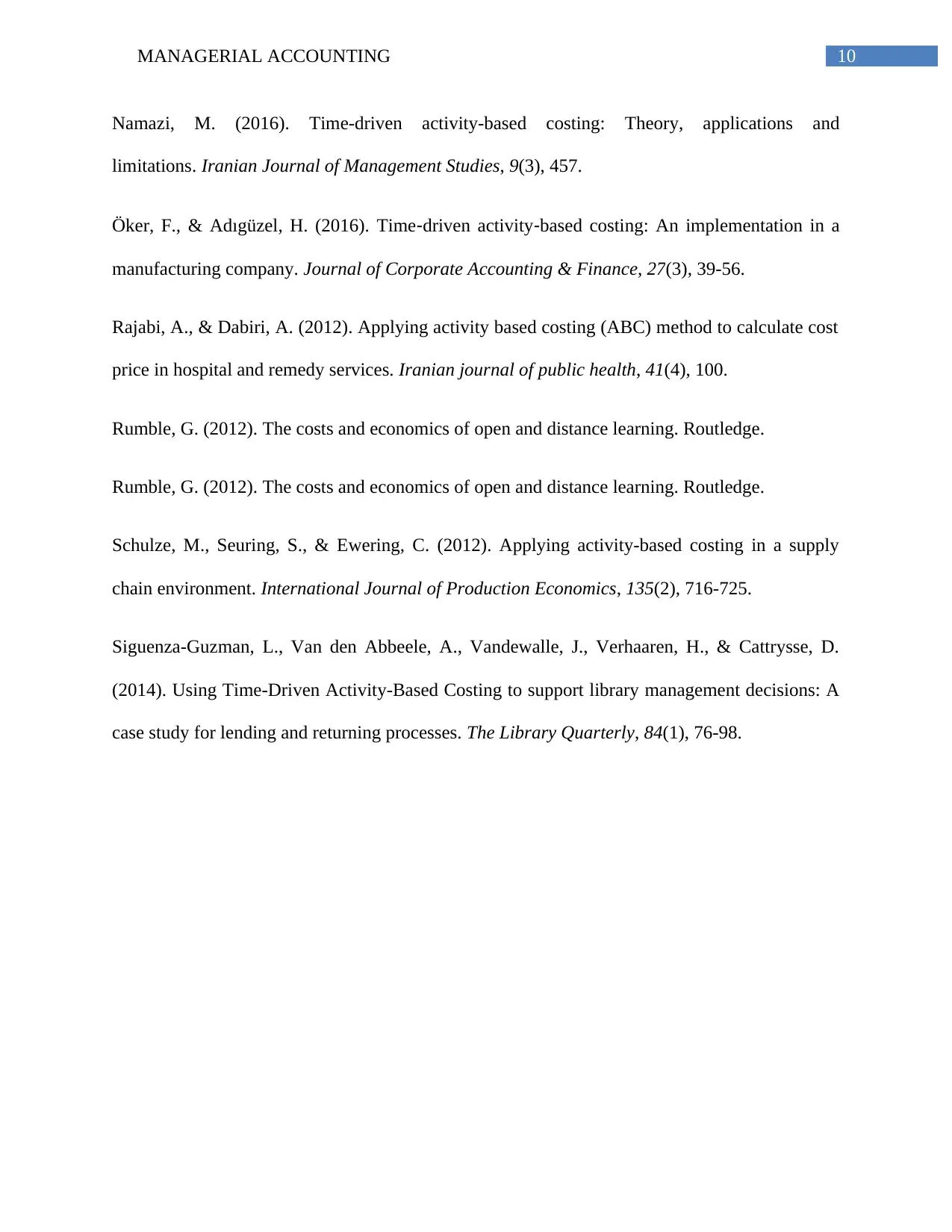
10MANAGERIAL ACCOUNTING
Namazi, M. (2016). Time-driven activity-based costing: Theory, applications and
limitations. Iranian Journal of Management Studies, 9(3), 457.
Öker, F., & Adıgüzel, H. (2016). Time‐driven activity‐based costing: An implementation in a
manufacturing company. Journal of Corporate Accounting & Finance, 27(3), 39-56.
Rajabi, A., & Dabiri, A. (2012). Applying activity based costing (ABC) method to calculate cost
price in hospital and remedy services. Iranian journal of public health, 41(4), 100.
Rumble, G. (2012). The costs and economics of open and distance learning. Routledge.
Rumble, G. (2012). The costs and economics of open and distance learning. Routledge.
Schulze, M., Seuring, S., & Ewering, C. (2012). Applying activity-based costing in a supply
chain environment. International Journal of Production Economics, 135(2), 716-725.
Siguenza-Guzman, L., Van den Abbeele, A., Vandewalle, J., Verhaaren, H., & Cattrysse, D.
(2014). Using Time-Driven Activity-Based Costing to support library management decisions: A
case study for lending and returning processes. The Library Quarterly, 84(1), 76-98.
Namazi, M. (2016). Time-driven activity-based costing: Theory, applications and
limitations. Iranian Journal of Management Studies, 9(3), 457.
Öker, F., & Adıgüzel, H. (2016). Time‐driven activity‐based costing: An implementation in a
manufacturing company. Journal of Corporate Accounting & Finance, 27(3), 39-56.
Rajabi, A., & Dabiri, A. (2012). Applying activity based costing (ABC) method to calculate cost
price in hospital and remedy services. Iranian journal of public health, 41(4), 100.
Rumble, G. (2012). The costs and economics of open and distance learning. Routledge.
Rumble, G. (2012). The costs and economics of open and distance learning. Routledge.
Schulze, M., Seuring, S., & Ewering, C. (2012). Applying activity-based costing in a supply
chain environment. International Journal of Production Economics, 135(2), 716-725.
Siguenza-Guzman, L., Van den Abbeele, A., Vandewalle, J., Verhaaren, H., & Cattrysse, D.
(2014). Using Time-Driven Activity-Based Costing to support library management decisions: A
case study for lending and returning processes. The Library Quarterly, 84(1), 76-98.
1 out of 11
Related Documents
Your All-in-One AI-Powered Toolkit for Academic Success.
+13062052269
info@desklib.com
Available 24*7 on WhatsApp / Email
![[object Object]](/_next/static/media/star-bottom.7253800d.svg)
Unlock your academic potential
Copyright © 2020–2025 A2Z Services. All Rights Reserved. Developed and managed by ZUCOL.





